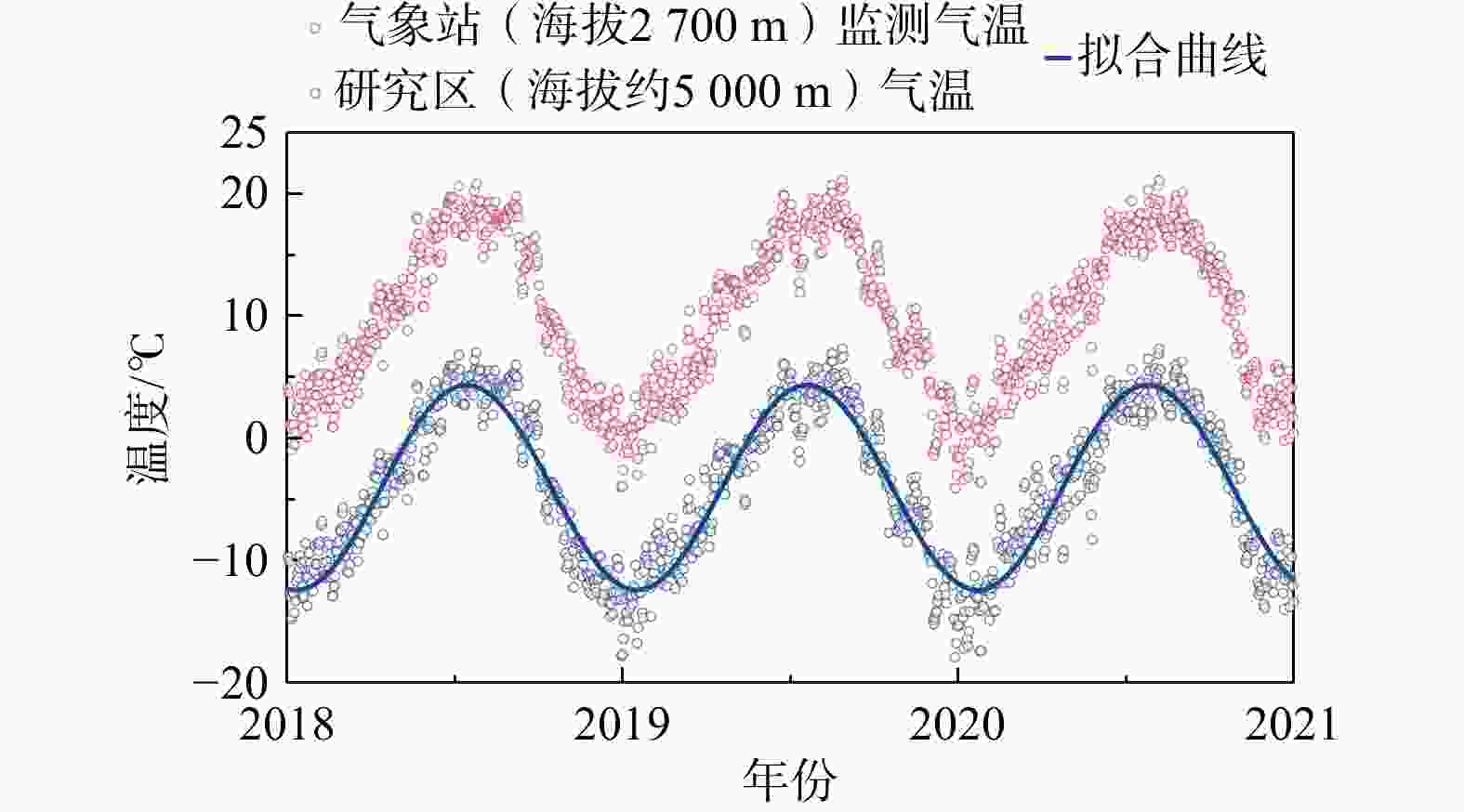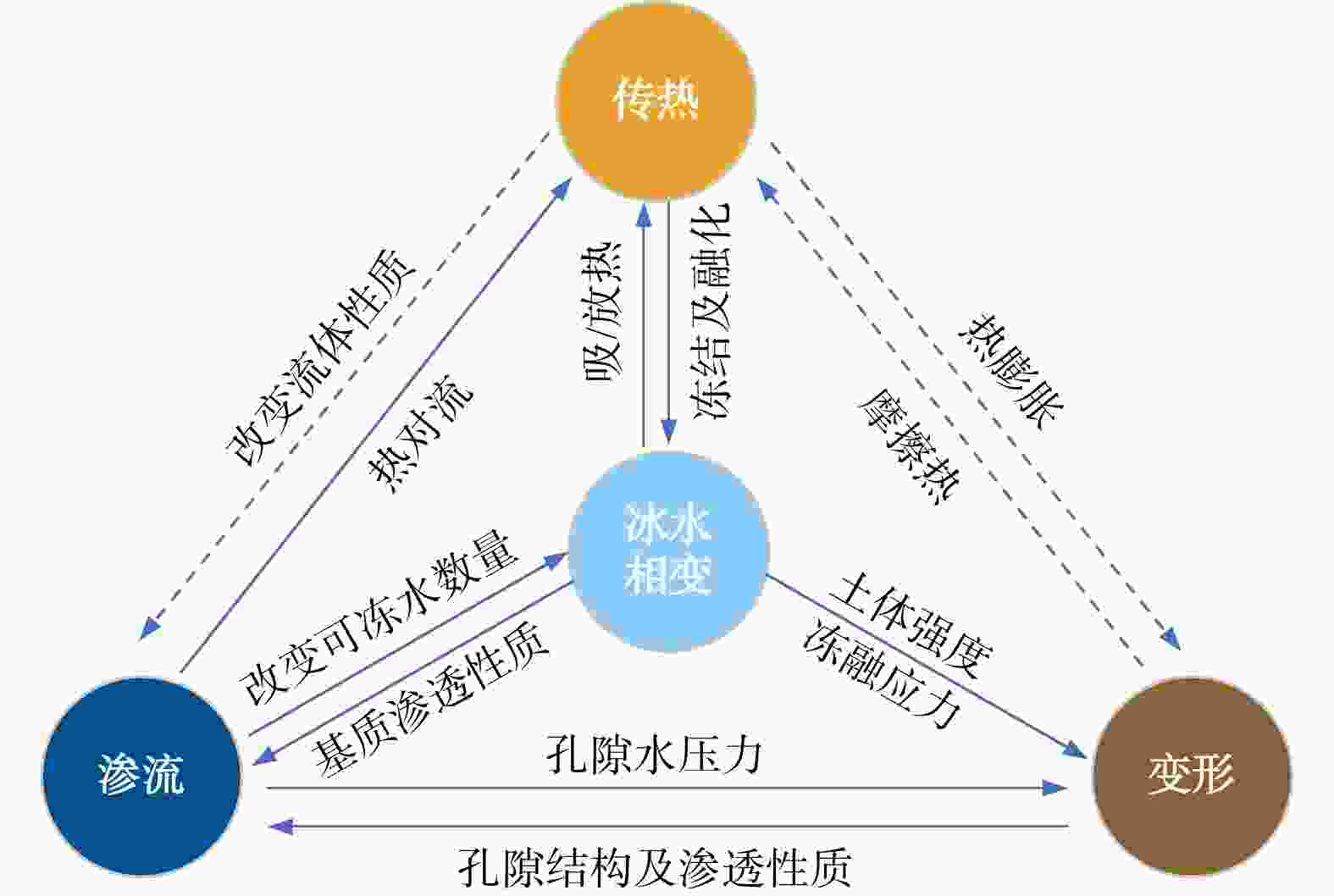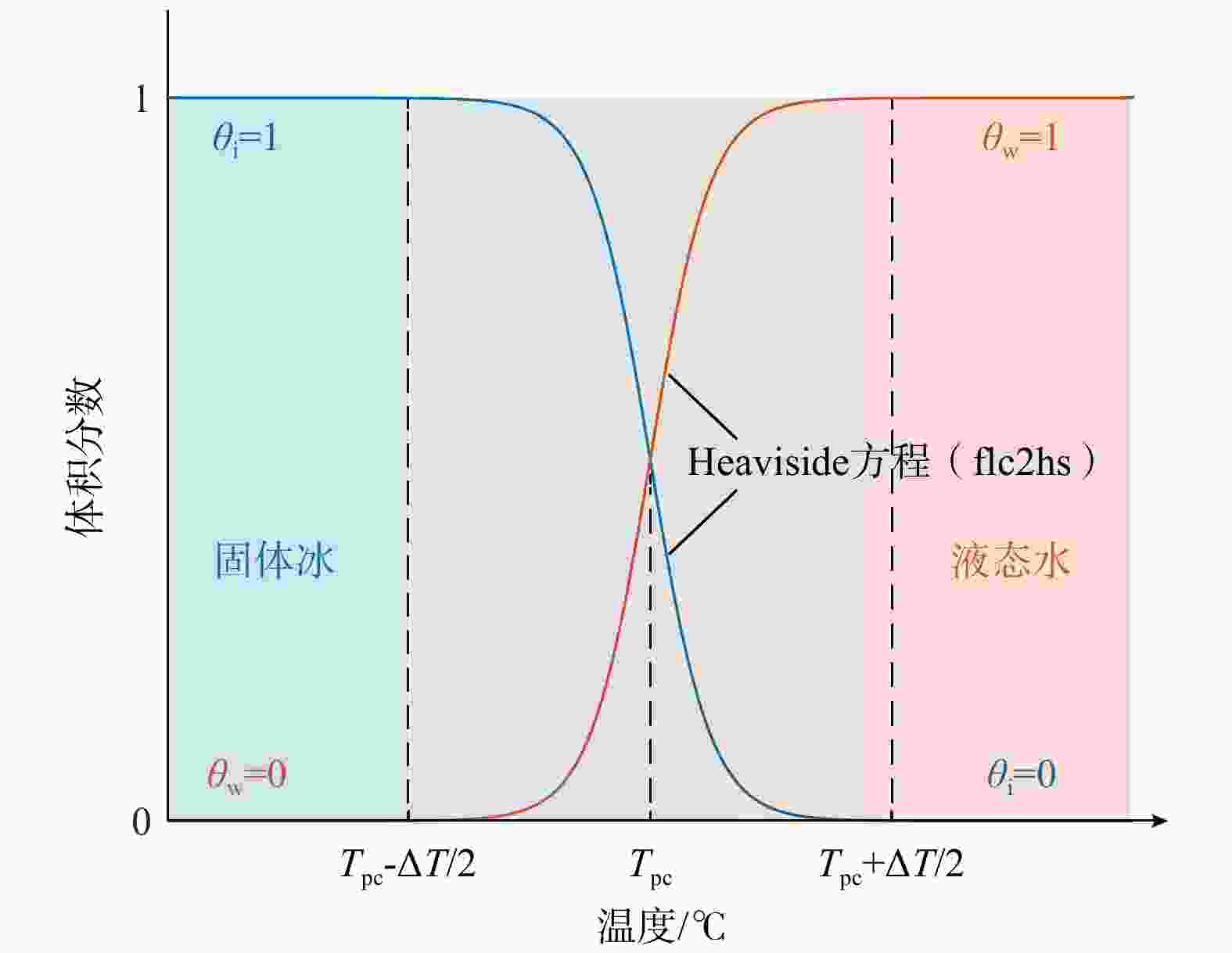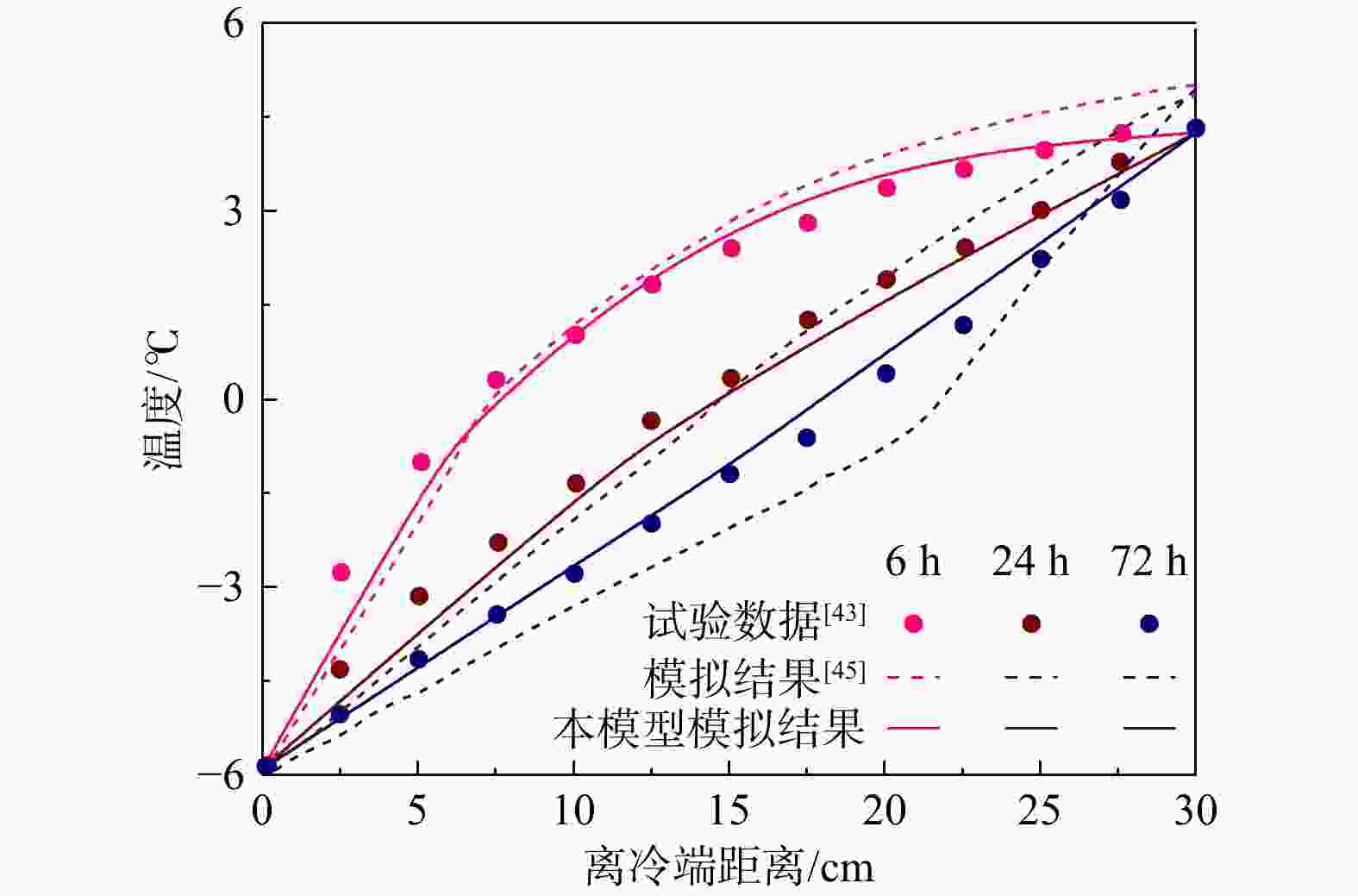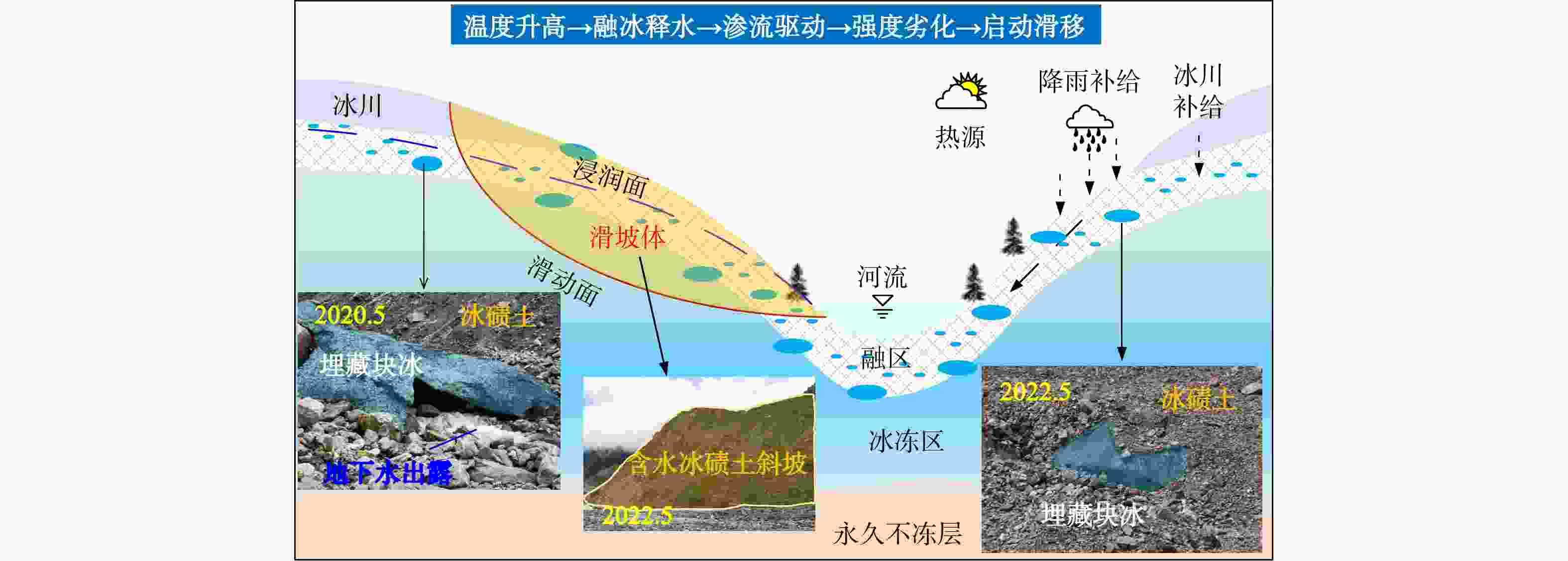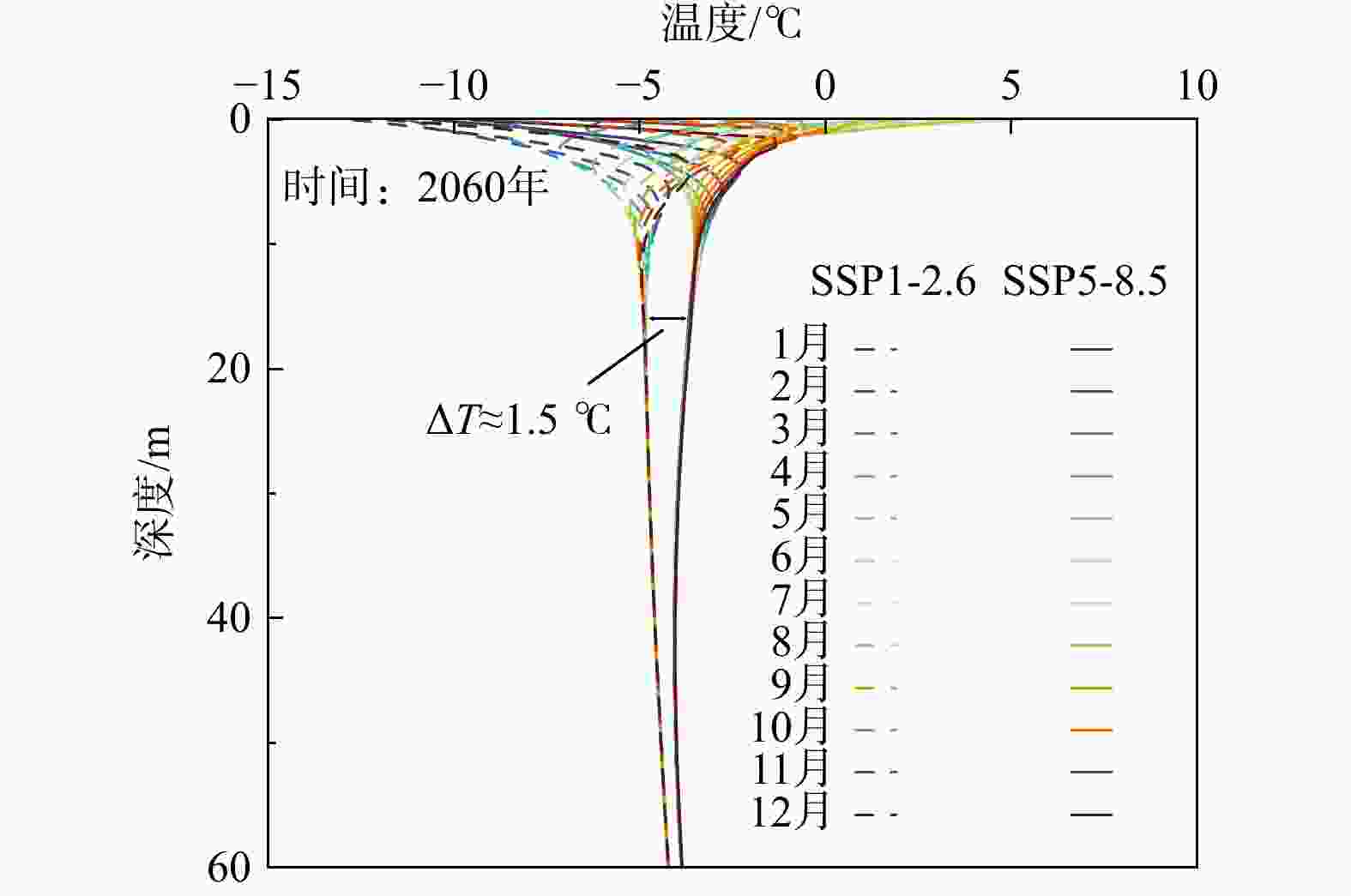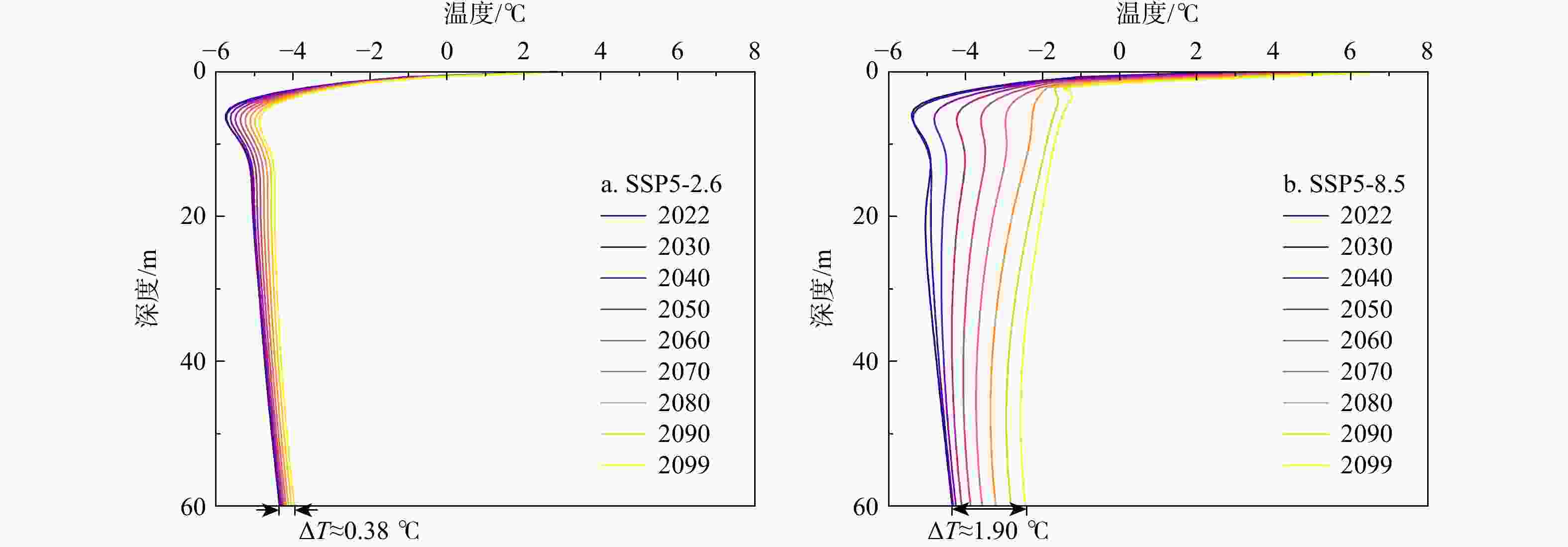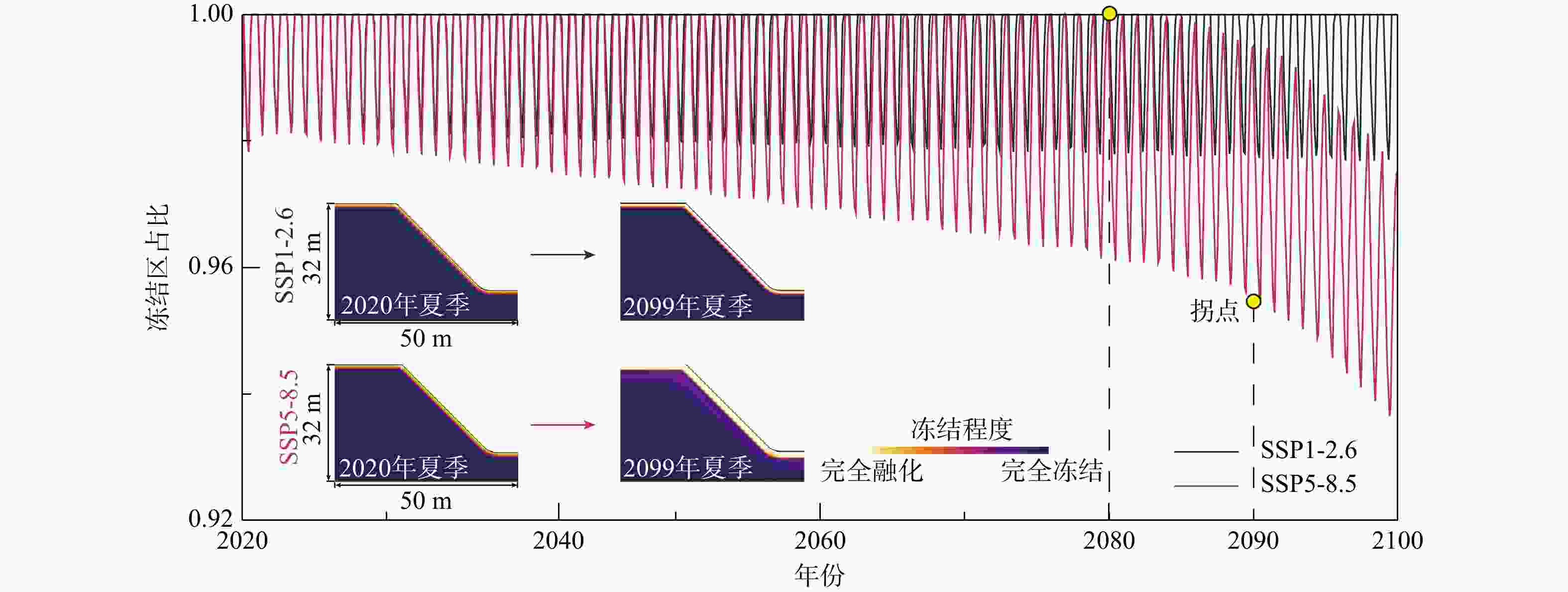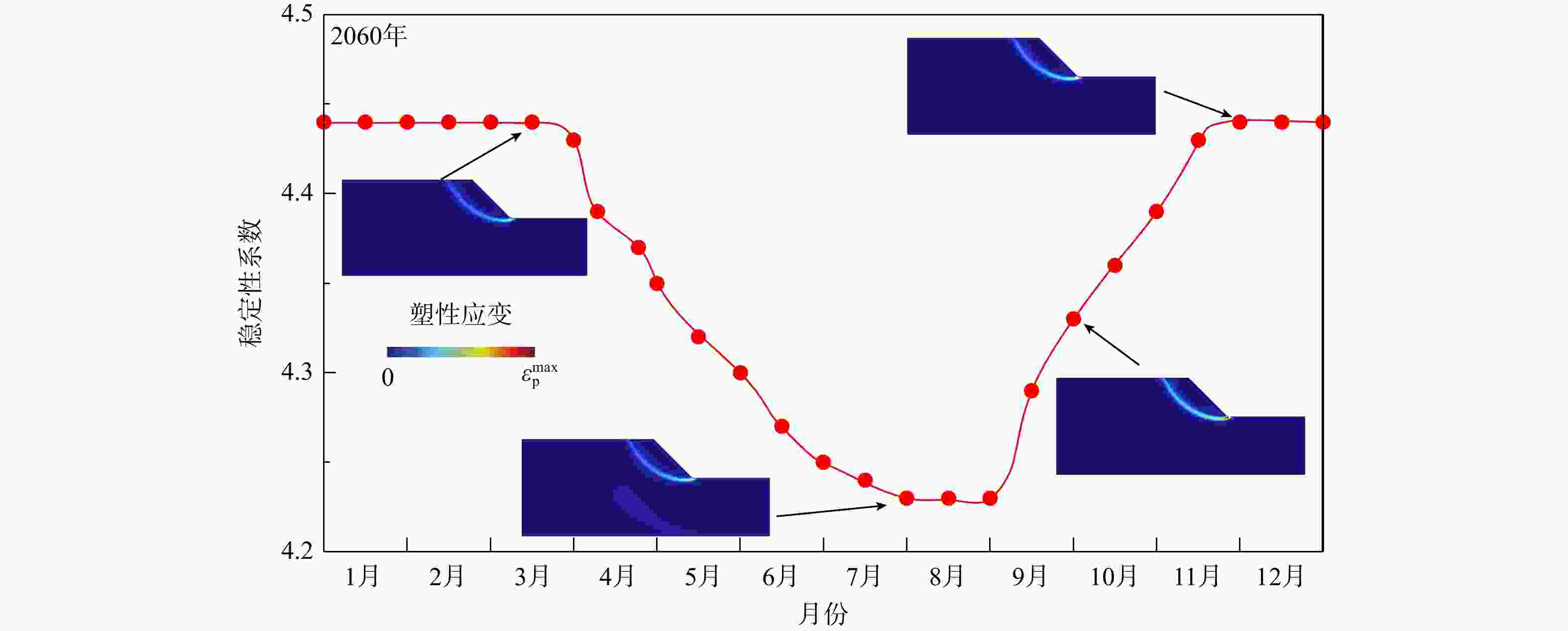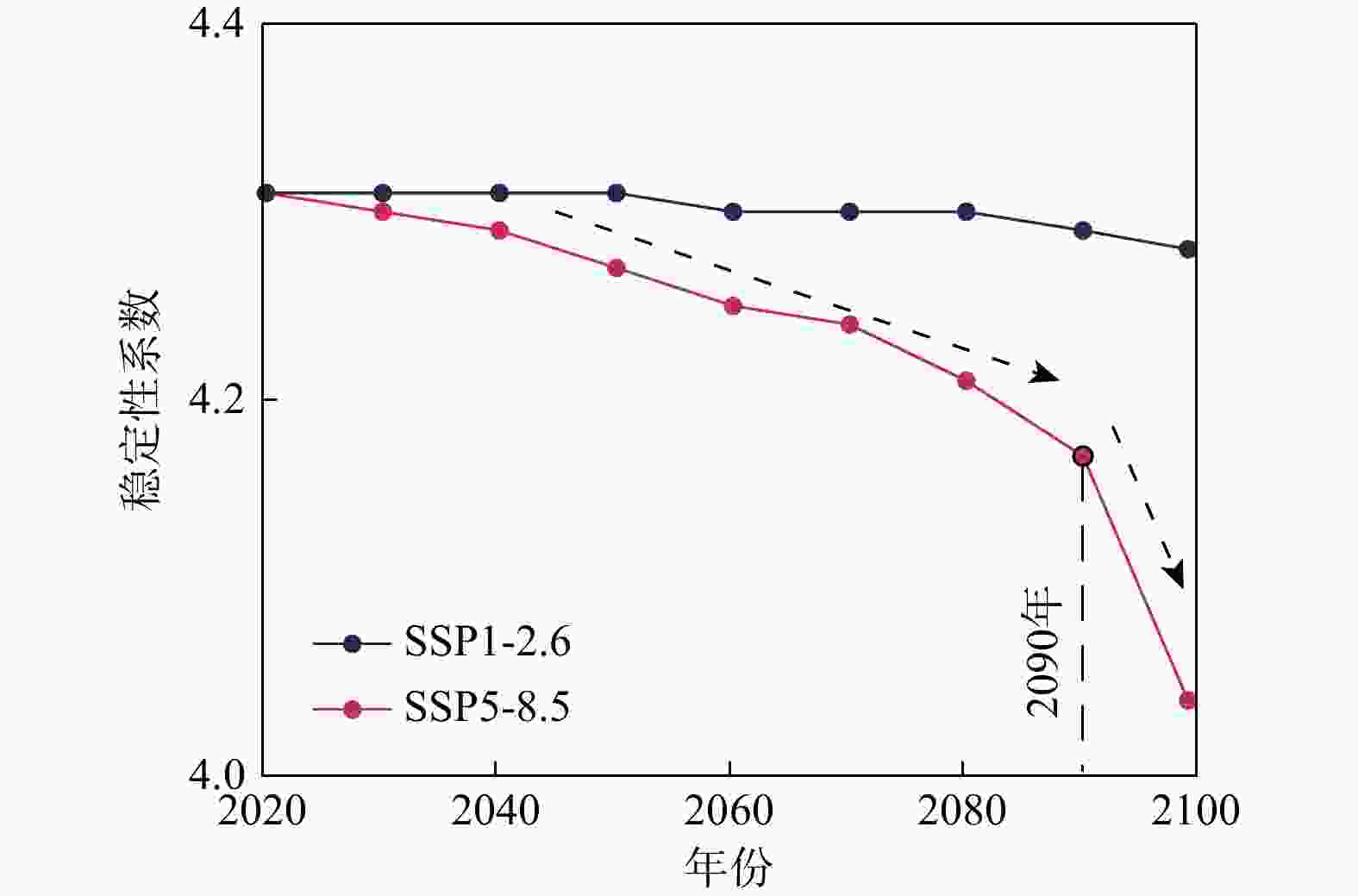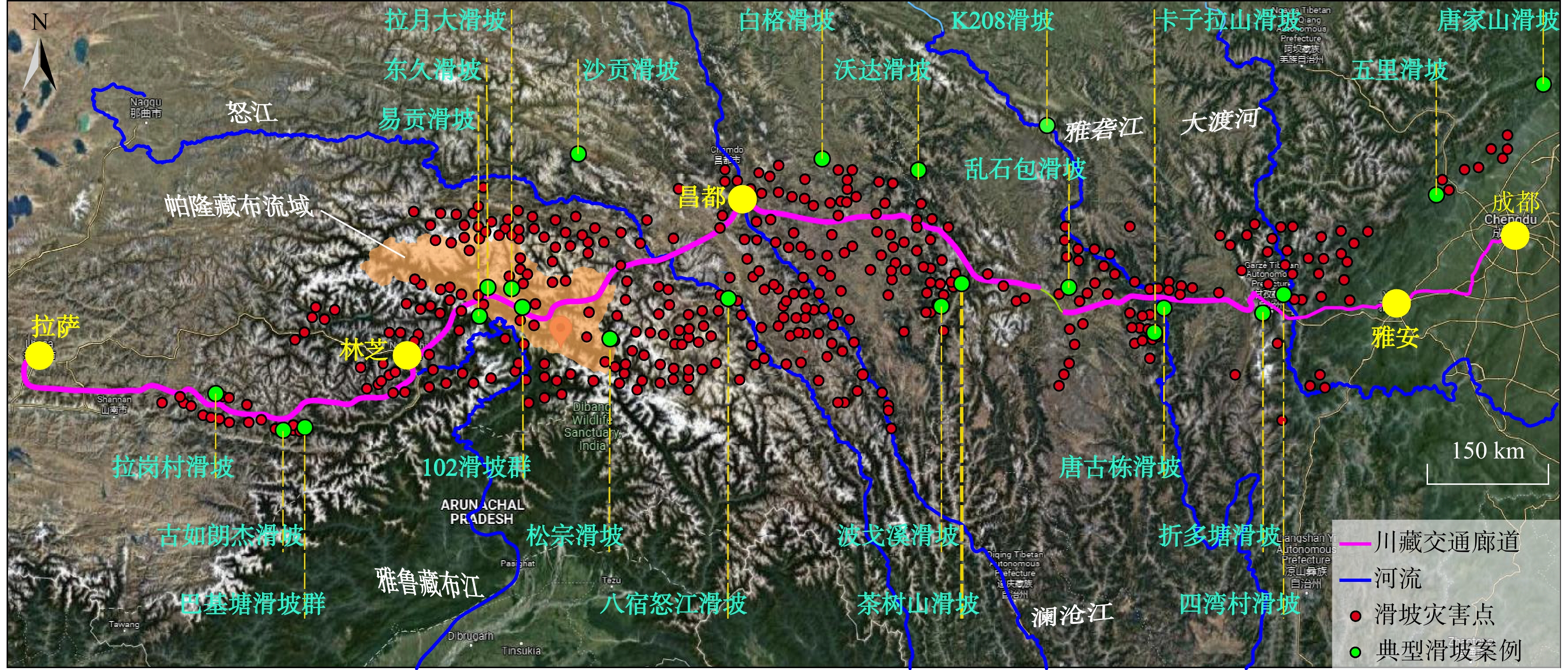Coupling characteristics and stability evolution of ice-rich moraine soil slopes on the Tibetan Plateau under climate change
-
摘要:
全球气候变暖形势严峻,温度的升高将直接导致广泛分布于青藏高原的各类含冰堆积体与冻结堆积体出现冻结区退化、热融沉降、失稳破坏等一系列工程地质问题。随着青藏地区人类生产实践与工程活动的日益频繁,这些工程地质问题将严重威胁着该地区的人民生命财产安全和重大工程建设进程。本研究建立了考虑冰水相变作用的岩土体渗流-传热-变形耦合数值模型,并通过与已有试验研究以及数值模拟研究的结果进行对比,充分验证了所搭建耦合模拟方法的有效性。基于所搭建的耦合模拟方法,聚焦帕隆藏布流域广泛分布的含冰冰碛土斜坡,结合历史气象数据和气候预测数据(SSP1-2.6与SSP5-8.5两种情景下),开展了自2020-2100年,时长80 a的斜坡多场耦合模拟与长期稳定性计算研究。结果表明,坡体内部各深度土体在长期变暖进程中均呈现不同程度的升温,并进一步导致坡体内部冻结区出现不可逆转的退化,从而导致相应的不可逆转的热融沉降与稳定性下降现象。冻结区的退化与其相应导致的不良工程地质现象受未来不同气候演化模式影响巨大。在SSP5-8.5情景下,持续升温至2080年前后,年均大气温度共抬升了3.84 ℃,坡体内部开始出现冻结区不可逆的退化与随之出现的不可逆沉降现象。在2080年坡体表层出现冻结区永久退化之后,坡体的热融沉降进程与稳定性的下降过程开始出现显著的加速现象,直至2100年,坡体热融沉降可达0.06 m,坡体稳定性较2020年下降了6.3%,这一非线性演化特征深刻反映了含冰土体这一特殊岩土材料在温度升高作用下由量变向质变转变的演化过程。而在SSP1-2.6情景下,冰碛土斜坡并未出现显著的冻结区退化与稳定性劣化的现象。本文构建的嵌入气候模型、考虑了冰水相变的岩土体温度-渗流-应力多场耦合模拟平台,量化评估了不同未来气候情景下坡体退化程度与失稳风险,揭示了气候驱动下含冰冰碛土斜坡水热力多场响应机制,阐明了斜坡长期稳定性演化规律,其成果为高寒高海拔地区地质灾害气候响应和区域地质风险评估奠定了重要理论基础。
Abstract:Objective The climate warming is severe on a global scale, and the increase in temperature directly leads to a series of engineering geological problems, such as the degradation of frozen regions, thermal thawing-induced subsidence, and the failure of various types of ice-rich and frozen geological structures widely distributed in the Qinghai–Tibetan Plateau. With the increasing frequency of human production practices and engineering construction in the Qinghai–Tibet region, these problems seriously threaten the safety of people's lives and property as well as the construction process of major projects in the region.
Methods A coupled numerical model of seepage, heat transfer, and deformation considering the water–ice phase transition was established in this study, and its efficiency and accuracy were validated by comparisons with previous experimental and simulated studies. Focusing on the widely distributed moraine slopes containing ice in the Parlung Tsangpo Basin, combined with historical meteorological data and climate prediction data (under the scenarios of SSP1-2.6 and SSP5-8.5), the multi field simulation and long-term stability calculation of slopes were carried out for 80 years from 2020 to 2100.
Results The results revealed that the soil at different depths inside the slope body was warmed to different degrees under the effect of long-term warming process, which further leads to irreversible degradation of the frozen area inside the slope, resulting in irreversible melt-induced settlement and stability degradation. The degradation of frozen area and accompanying unfavorable geological problems are strongly affected by climate evolution patterns. As the temperature continues to rise until around 2080, the mean annual atmospheric temperature increased by 3.84℃ under SSP5-8.5, and irreversible degradation of the frozen zone and the consequent irreversible subsidence began to occur inside the slope. After the permanent degradation of the frozen zone in the surface layer of the slope in 2080, there was a significant acceleration of thawing-induced subsidence increases and stability decreases. Until 2100, thawing-induced subsidence of the slope could reach 0.06 m, and the stability of the slope decreased by 6.3% compared to 2020. This nonlinear evolution feature reveals the evolution mechanism of ice-rich soil from quantitative changes to qualitative changes under the effect of increasing temperature. However, these degradations did not appear under SSP1-2.6.
Conclusion In this study, a multiphysics coupled simulation platform of temperature-seepage-deformation behaviors that considers the ice–water phase transition was constructed. It quantitatively evaluated the degree of degradation and instability risk of slopes under different future climate scenarios, revealed the multifield response mechanism and long-term stability evolution of ice-rich moraine slopes driven by climate. The results provide an important theoretical foundation for understanding the climate response to geological hazards in high-cold regions and assessing regional geological risk.
-
图 4 考虑冰水相变作用下传热-渗流-变形耦合示意图(实线表示本模型中所考虑的耦合作用,虚线表示本模型所忽略的耦合作用)
Figure 4. Schematic diagram of heat-seepage-deformation coupling under the consideration of ice-water phase transition (solid line represents the coupling considered in this model, dashed line represents the coupling ignored in this model)
表 1 物理力学参数表
Table 1. Physical and mechanical parameters
参数 数值 描述 ρs 2600 kg/m3土体基质密度 ρw 1000 kg/m3水体密度 ρi 918 kg/m3 冰体密度 ε0 0.15 孔隙率 εr 0.05 残余含水率 ku 4×10−11 m2 融土渗透系数 μ 1.793×10−3 Pa·s 水体动力黏度 Ω 50 冰体阻抗系数 λs 1.07 W/(m·℃) 土体导热系数 λw 0.63 W/(m·℃) 水体导热系数 λi 2.31 W/(m·℃) 冰体导热系数 Cs 0.93 kJ/(kg·℃) 土体热容 Cw 4.2 kJ/(kg·℃) 水体热容 Ci 2.1 kJ/(kg·℃) 冰体热容 L 334.56 kJ/kg 冰水相变潜热 Es 100 MPa 土体杨氏模量 $ \nu $ 0.4 土体泊松比 cun 60 kPa 融土黏聚力 cf 200 kPa 冻土黏聚力 φun 25 ° 融土内摩擦角 φf 30 ° 冻土内摩擦角 -
[1] FAN X,DUAN Q,SHEN C,et al. Global surface air temperatures in CMIP6:Historical performance and future changes[J]. Environmental Research Letters,2020,15(10):104056. [2] Mountain Research Initiative EDW Working Group. Elevation-dependent warming in mountain regions of the world[J]. Nature Climate Change,2015,5(5):424-430. doi: 10.1038/nclimate2563 [3] BISKABORN B K,SMITH S L,NOETZLI J,et al. Permafrost is warming at a global scale[J]. Nature Communications,2019,10(1):264. doi: 10.1038/s41467-018-08240-4 [4] NITZBON J,WESTERMANN S,LANGER M,et al. Fast response of cold ice-rich permafrost in northeast Siberia to a warming climate[J]. Nature Communications,2020,11(1):2201. doi: 10.1038/s41467-020-15725-8 [5] YOU Q,CAI Z,PEPIN N,et al. Warming amplification over the Arctic Pole and Third Pole:Trends,mechanisms and consequences[J]. Earth-Science Reviews,2021,217:103625. doi: 10.1016/j.earscirev.2021.103625 [6] ZHANG G,YAO T,XIE H,et al. An inventory of glacial lakes in the Third Pole region and their changes in response to global warming[J]. Global and Planetary Change,2015,131:148-157. doi: 10.1016/j.gloplacha.2015.05.013 [7] ZHAO L,PING C L,YANG D,et al. Changes of climate and seasonally frozen ground over the past 30 years in Qinghai-Xizang (Tibetan) Plateau,China[J]. Global and Planetary Change,2004,43(1/2):19-31. doi: 10.1016/j.gloplacha.2004.02.003 [8] 崔鹏,郭剑. 沟谷灾害链演化模式与风险防控对策[J]. 工程科学与技术,2021,53(3):5-18.CUI P,GUO J. Evolution models,risk prevention and control counter measures of the valley disaster chain[J]. Advanced Engineering Science,2021,53(3):5-18. (in Chinese with English abstract [9] NEUPANE R,CHEN H,CAO C. Review of moraine dam failure mechanism[J]. Geomatics,Natural Hazards and Risk,2019,10(1):1948-1966. doi: 10.1080/19475705.2019.1652210 [10] RICHARDSON S D,REYNOLDS J M. Degradation of ice-cored moraine dams :Implications for hazard development[M]. Wallingford:IAHS Press,2000. [11] HEALY T R. Thermokarst:A mechanism of de-icing ice-cored moraines[J]. Boreas,2008,4(1):19-23. [12] HAEBERLI W,HUDER J,KEUSEN H,et al. Core drilling through rock glacier permafrost[C]//Anon. Proceedings of the Fith International Conference on Permafrost. [S. 1. ]:[S. n. ],1988:937-942. [13] 李德基,游勇. 西藏波密米堆冰湖溃决浅议[J]. 山地研究,1992,10(4):219-224.LI D J,YOU Y. Analysis on the outburst of the glacial lake in Bome Midui,Tibet[J]. Mountain Research,1992,10(4):219-224. (in Chinese with English abstract [14] 刘建康,张佳佳,高波,等. 我国西藏地区冰湖溃决灾害综述[J]. 冰川冻土,2019,41(6):1335-1347.LIU J K,ZHANG J J,GAO B,et al. An overview of glacial lake outburst flood in Tibet,China[J]. Journal of Glaciology and Geocryology,2019,41(6):1335-1347. (in Chinese with English abstract [15] 王欣,蒋亮虹,刘时银,等. 喜马拉雅山北坡冰碛湖坝温度特征及其对堤坝稳定的影响[J]. 冰川冻土,2014,36(6):1517-1525.WANG X,JIANG L H,LIU S Y,et al. Temperature features of a moraine-dam on north slopes of the Himalayas and their effect on the dam stability[J]. Journal of Glaciology and Geocryology,2014,36(6):1517-1525. (in Chinese with English abstract [16] 蒋婷婷,潘华利,艾一帆,等. 冻融循环及含水率对冰碛土力学特性影响[J]. 地质科技通报,2024,43(2):238-252.JIANG T T,PAN H L,AI Y F et al. ,Effect of freeze-thaw cycles and water content on the mechanical properties of moraine soil[J]. Bulletin of Geological Science and Technology,2024,43(2):238-252. (in Chinese with English abstract [17] 高波,张佳佳,王军朝,等. 西藏天摩沟泥石流形成机制与成灾特征[J]. 水文地质工程地质,2019,46(5):144-153.GAO B,ZHANG J J,WANG J C,et al. Formation mechanism and disaster characteristics of debris flow in the Tianmo gully in Tibet[J]. Hydogeology & Engineering Geology,2019,46(5):144-153. (in Chinese with English abstract [18] MCROBERTS E C,MORGENSTERN N R. The stability of thawing slopes[J]. Canadian Geotechnical Journal,1974,11(4):447-469. doi: 10.1139/t74-052 [19] 王绍令. 青藏公路风火山地区的热融滑塌[J]. 冰川冻土,1990,12(1):63-70.WANG S L. Thermal melt collapse in Feng-volcano area of Qinghai-Tibet Highway[J]. Journal of Glaciology and Geocryology,1990,12(1):63-70. (in Chinese with English abstract [20] 靳德武,牛富俊,李宁. 青藏高原多年冻土区热融滑塌变形现场监测分析[J]. 工程地质学报,2006,14(5):677-682. doi: 10.3969/j.issn.1004-9665.2006.05.019JIN D W,NIU F J,LI N. In-situ monitoring and analysis of thaw slumping and deformation in gentle slopeing ground of permafrost soils on Qinghai-Tibet Plateau[J]. Journal of Engineering Geology,2006,14(5):677-682. (in Chinese with English abstract doi: 10.3969/j.issn.1004-9665.2006.05.019 [21] SHAN W,ZHANG C C,GUO Y. Mechanism of shallow slide on soil road cutting slope during spring in seasonal frozen region[J]. Applied Mechanics and Materials,2012,178/181:1258-1263. doi: 10.4028/www.scientific.net/AMM.178-181.1258 [22] 王超. 季冻区哈大高铁边坡冻融滑塌机理研究[D]. 哈尔滨:哈尔滨工业大学,2014.WANG C. Research on freeze-thaw slumping mechanism of harbin-dalian high-speed railway slope in seasonally frozen soil region[D]. Harbin:Harbin Institute of Technology,2014. (in Chinese with English abstract [23] KORSHUNOV A A,DOROSHENKO S P,Nevzorov A L. The impact of freezing-thawing process on slope stability of earth structure in cold climate[J]. Procedia Engineering,2016,143:682-688. doi: 10.1016/j.proeng.2016.06.100 [24] 李智明. 冻土水热力场耦合机理研究与工程应用[D]. 哈尔滨:哈尔滨工业大学,2017.LI Z M. Study on mechanisum of moisture-heat-stress coupling for frozen soil and engineering application[D]. Harbin:Harbin Institute of Technology,2017. (in Chinese with English abstract [25] CUI K,QIN X. Landslide risk assessment of frozen soil slope in Qinghai-Tibet Plateau during spring thawing period under the coupling effect of moisture and heat[J]. Natural Hazards,2023,115(3):2399-2416. doi: 10.1007/s11069-022-05646-8 [26] GE Q,WU H,GONG Y F. Research on the soil slope stability based on soil strength deterioration in seasonal frozen areas[J]. Advanced Materials Research,2011,243/249:4270-4273. doi: 10.4028/www.scientific.net/AMR.243-249.4270 [27] 李书林,张哲华,陈鑫鑫,等. 浅析冻融循环作用下青藏高原冻土区软弱结构面长期稳定性[J]. 科学技术创新,2020(26):129-130. doi: 10.3969/j.issn.1673-1328.2020.26.058LI S L,ZHANG Z H,CHEN X X,et al. Analysis on the long-term stability of weak structural plane in the frozen soil region of Qinghai-Tibet Plateau under the action of freeze-thaw cycle[J]. Science and Technology Innovation,2020(26):129-130. (in Chinese with English abstract doi: 10.3969/j.issn.1673-1328.2020.26.058 [28] KAWAMURA S,MIURA S. Stability evaluation of volcanic slope subjected to rainfall and freeze-thaw action based on field monitoring[J]. Advances in Civil Engineering,2011(1):1-14. [29] NIU F,LUO J,LIN Z,et al. Thaw-induced slope failures and stability analyses in permafrost regions of the Qinghai-Tibet Plateau,China[J]. Landslides,2016,13(1):55-65. doi: 10.1007/s10346-014-0545-2 [30] XU J,WANG Z Q,REN J W,et al. Mechanism of slope failure in loess terrains during spring thawing[J]. Journal of Mountain Science,2018,15(4):845-858. doi: 10.1007/s11629-017-4584-8 [31] 宋勇军,操警辉,程柯岩,等. 砂岩冻结/解冻过程蠕变特性研究[J]. 水文地质工程地质,2024,51(6):93-103.SONG Y J,CAO J H,CHENG K Y,et al. Creep characteristics of sandstone durir:g freezing/thawing process[J]. Hydrogeology & Engineering Geology,2024,51(6):93-103.(in Chinese with English abstract [32] 陈兰,范宣梅,熊俊麟,等. 藏东南多依弄巴流域冰湖溃决危险性评价[J]. 地质科技通报,2023,42(2):258-266.CHEN L,FAN X M,XIONG J L,et al. Hazard assessment of glacial lake outbursts in the Doyinongba Basin,southeastern Tibetan Plateau[J]. Bulletin of Geological Science and Technology,2023,42(2):258-266. (in Chinese with English abstract [33] 郭长宝,吴瑞安,蒋良文,等. 川藏铁路雅安-林芝段典型地质灾害与工程地质问题[J]. 现代地质,2021,35(1):1-17.GUO C B,WU R A,JIANG L W,et al. Typical geohazards and engineering geological problems along the Ya'an-Linzhi section of the Sichuan-Tibet Railway,China[J]. Geoscience,2021,35(1):1-17. (in Chinese with English abstract [34] GROVE J M. Little ice ages:Vol. 2[M]. Ed2. Routledge:[S. n. ],2013. [35] 焦世晖,王凌越,刘耕年. 全球变暖背景下青藏高原多年冻土分布变化预测[J]. 北京大学学报(自然科学版),2016,52(2):249-256.JIAO S H,WANG L Y,LIU G N. Prediction of Tibetan Plateau permafrost distribution in global warming[J]. Acta Scientiarum Naturalium Universitatis Pekinensis,2016,52(2):249-256. (in Chinese with English abstract [36] 李述训,吴通华. 青藏高原地气温度之间的关系[J]. 冰川冻土,2012,27(5):627-632.LI S X,WU T H. The relationship between earth,air and temperature in Qinghai-Tibet Plateau[J]. Journal of Glaciology and Geocryology,2012,27(5):627-632. (in Chinese with English abstract [37] O’NEILL B C,TEBALDI C,VAN VUUREN D P,et al. The Scenario Model Intercomparison Project (ScenarioMIP) for CMIP6[J]. Geoscientific Model Development,2016,9(9):3461-3482. doi: 10.5194/gmd-9-3461-2016 [38] GRENIER C,ANBERGEN H,BENSE V,et al. Groundwater flow and heat transport for systems undergoing freeze-thaw:Intercomparison of numerical simulators for 2D test cases[J]. Advances in Water Resources,2018,114:196-218. [39] MCKENZIE J M,VOSS C I,SIEGEL D I. Groundwater flow with energy transport and water-ice phase change:Numerical simulations,benchmarks,and application to freezing in peat bogs[J]. Advances in Water Resources,2007,30(4):966-983. doi: 10.1016/j.advwatres.2006.08.008 [40] VAN GENUCHTEN M T H. A closed-form equation for predicting the hydraulic conductivity of unsaturated soils[J]. Soil Science Society of America Journal,1980,44(5):892-898. doi: 10.2136/sssaj1980.03615995004400050002x [41] BIOT M A,Willis D G. The elastic coefficients of the theory of consolidation[J]. Journal of Applied Mechanics,2021,24(4):594-601. [42] KURYLYK B L,WATANABE K. The mathematical representation of freezing and thawing processes in variably-saturated,non-deformable soils[J]. Advances in Water Resources,2013,60:160-177. doi: 10.1016/j.advwatres.2013.07.016 [43] JAME Y W. Heat and mass transfer in freezing unsaturated soil[D]. [S. 1. ]:University of Saskatchewan,1977. [44] PENG E X,SHENG Y,HU X Y,et al. Thermal effect of thermokarst lake on the permafrost under embankment[J]. Advances in Climate Change Research,2021,12(1):76-82. doi: 10.1016/j.accre.2020.10.002 [45] HUANG X,RUDOLPH D L,Glass B. A coupled thermal‐hydraulic‐mechanical approach to modeling the impact of roadbed frost loading on water main failure[J]. Water Resources Research,2022,58(3):e2021WR030933. [46] JI H,NAN Z,HU J,et al. On the spin-up strategy for spatial modeling of permafrost dynamics:A case study on the Qinghai-Tibet Plateau[J]. Journal of Advances in Modeling Earth Systems,2022,14(3):e2021MS002750. -




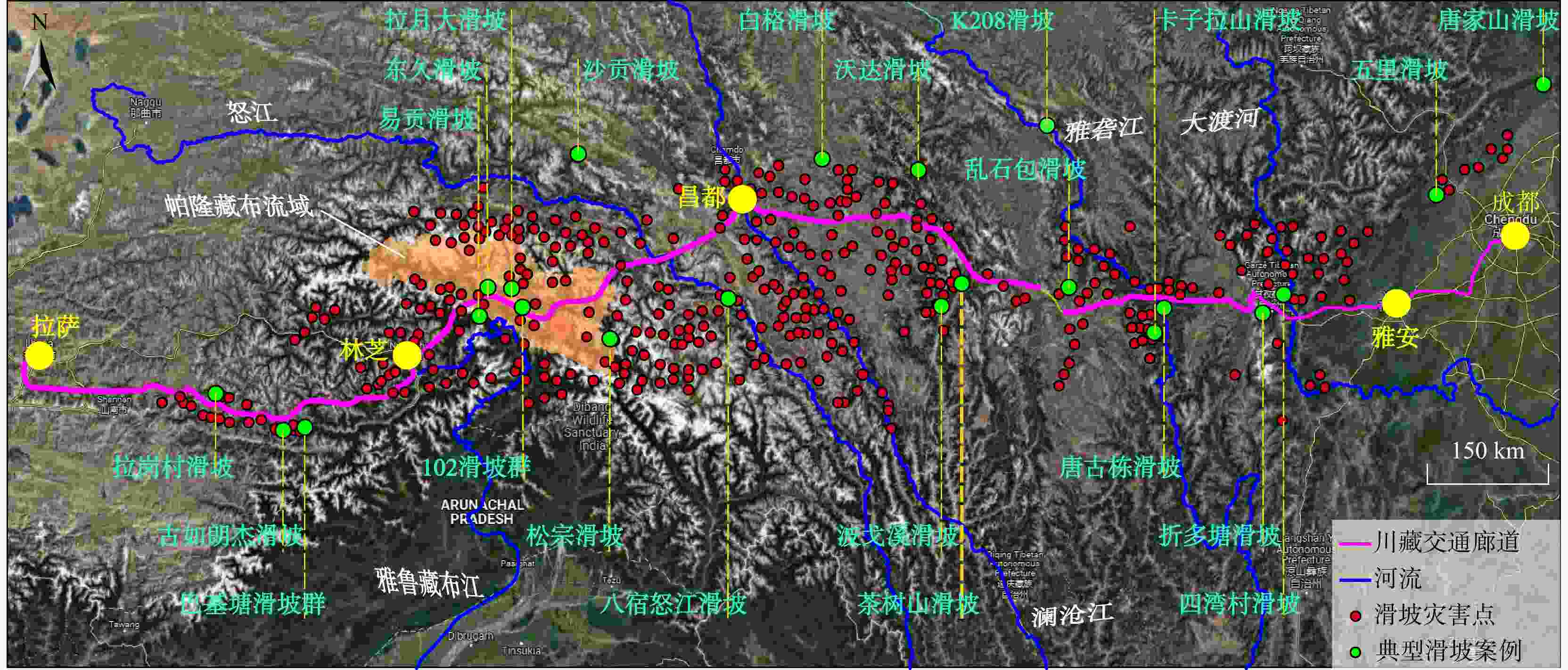
 下载:
下载:
